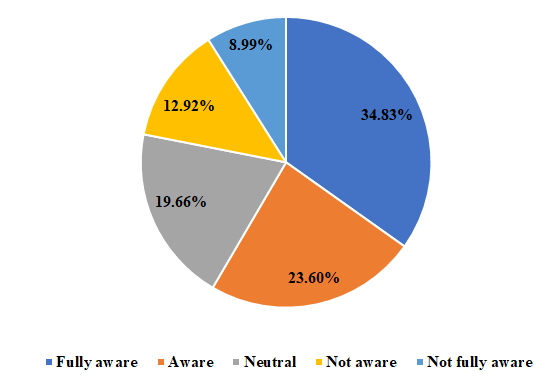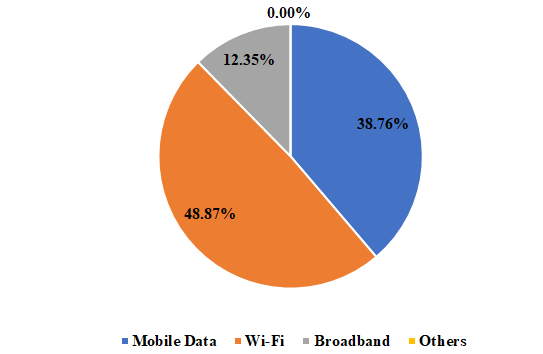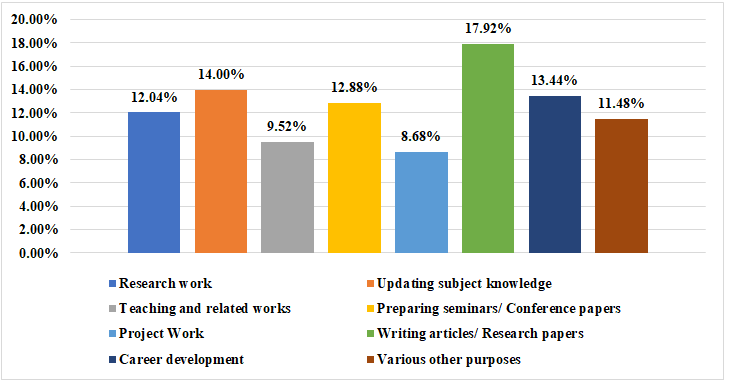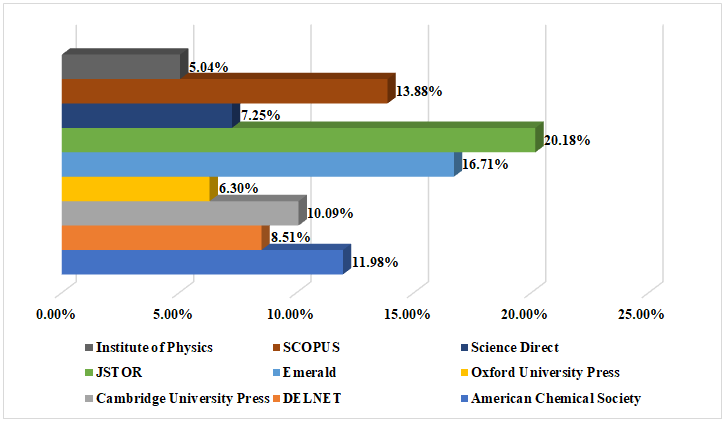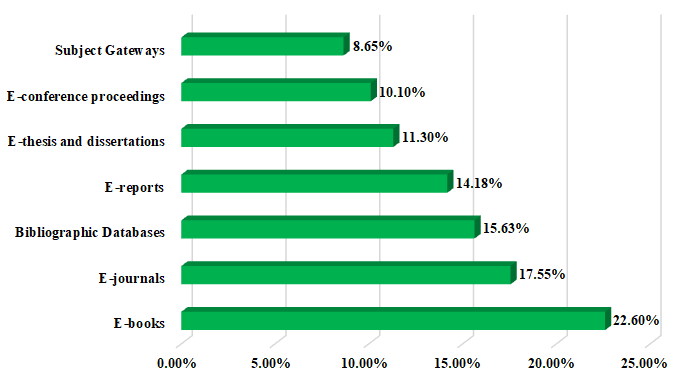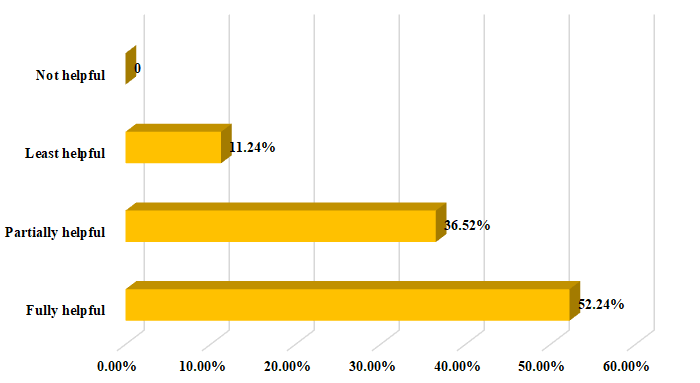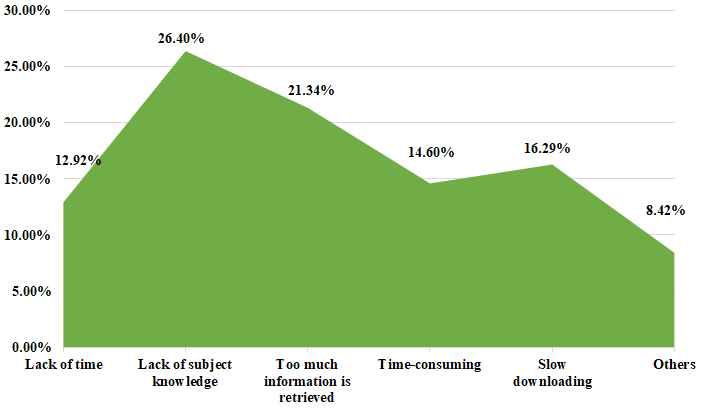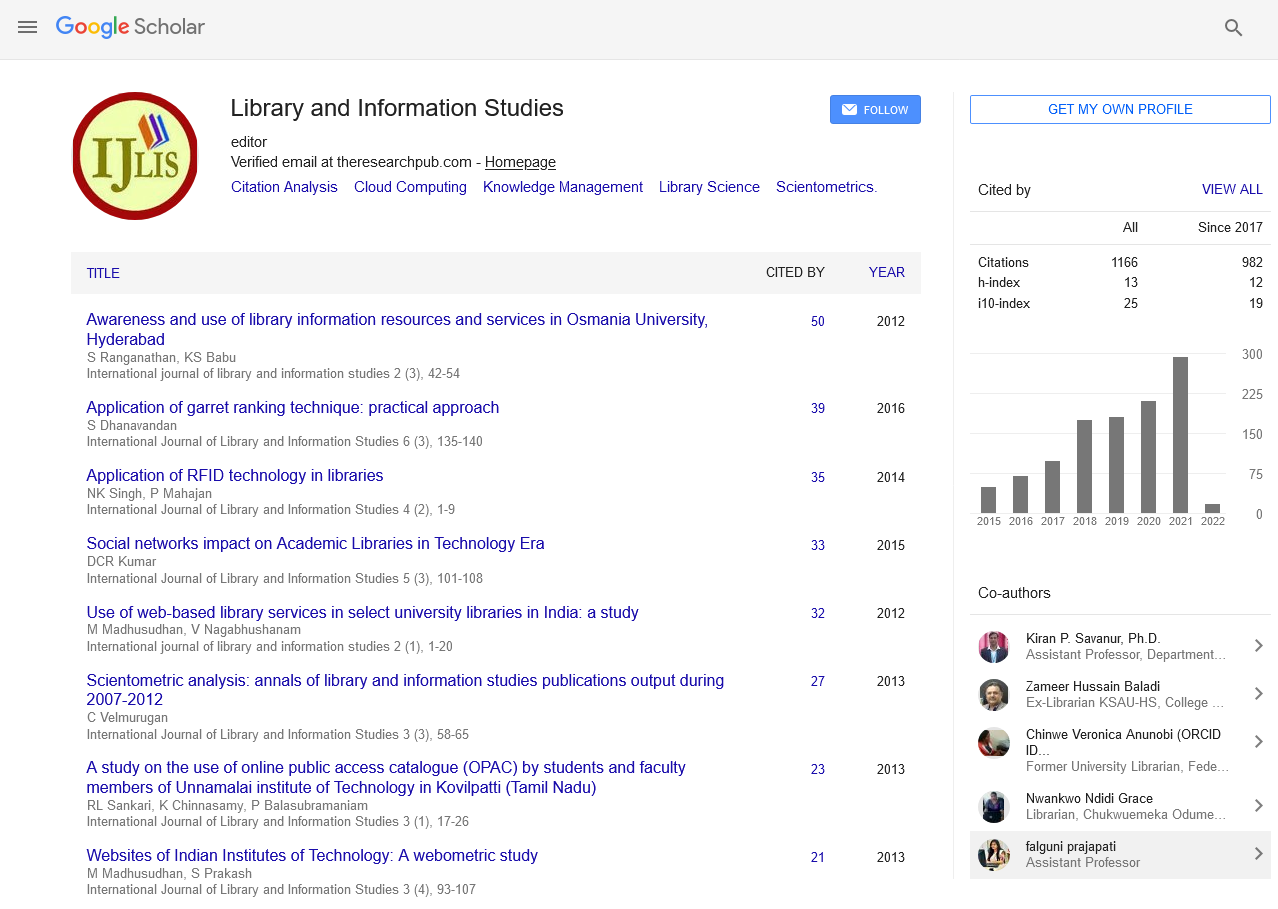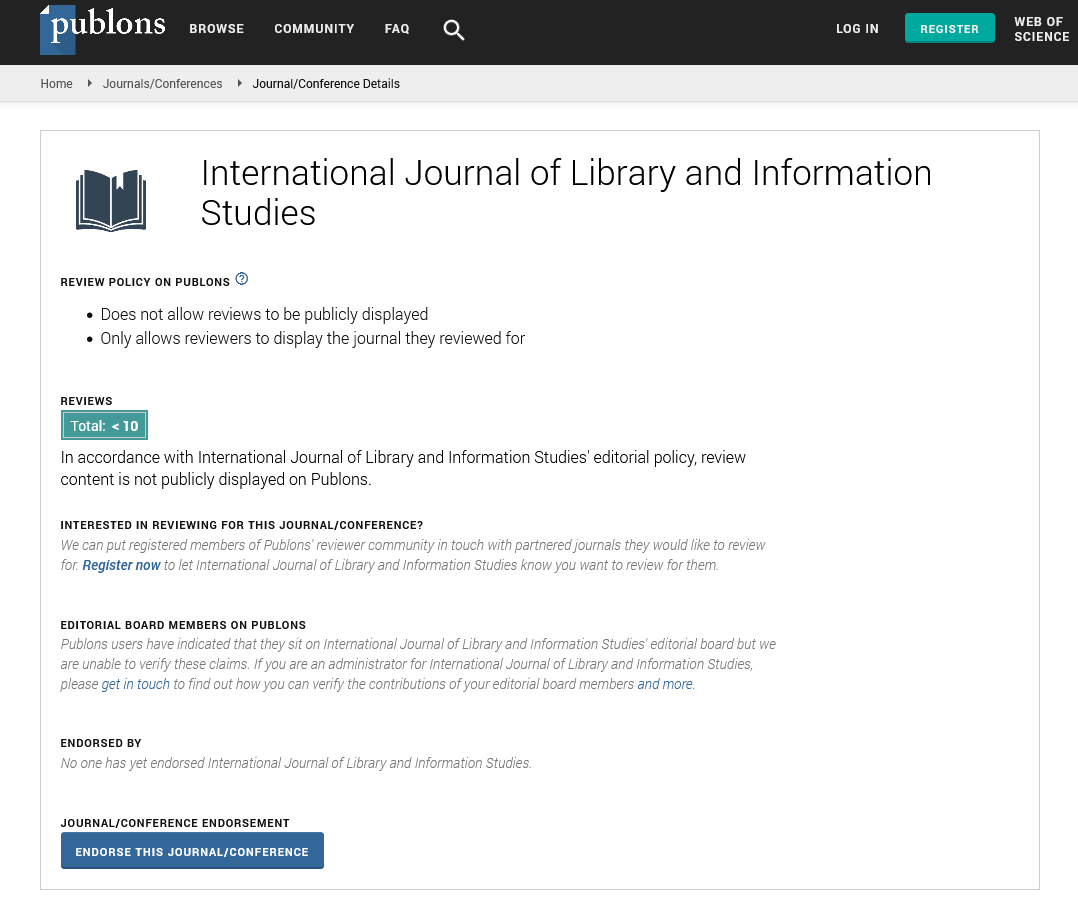Research Article - (2023) Volume 13, Issue 1
Usage Pattern of Various Types of E-Resources by the Students of the University of Jammu: A Neutral Overview
Avinash Singh Charak1*, Meghabat Singh2* and Raj Singh3*Abstract
In this paper, an attempt has been regarding the studying, analyzing, evaluating, and usage of various types of electronic resources in the form of e-databases, e-journals, e-books, e-reports, e-thesis, etc. that are provided to the students and respondents of the university of Jammu. In this study, the major focal point is based on the respondents regarding their awareness, formal training, role, purpose, and usage of the electronic resources available in the libraries of the university of Jammu. In our study, it was witnessed that 62 (34.83%) out of a total of 178 respondents were fully aware of the various e-resources available. One of the major findings was that 66 (37.07%) of the respondents were satisfied with the e-resources available in the different libraries of the university.
Keywords
E-resources, Digital resources, University of Jammu.
Introduction
E-resources or electronic resources are those information resources that are provided in an online mode through a computer network. E-resources can also be called online information resources. The materials and the resources which are provided to us by the library in a compact physical form are now being replaced by the online form of resources like electronic books, electronic journals, bibliographic databases, electronic thesis and dissertations, and electronic newspapers, electronic reports, and various subject gateways. Electronic resources are also available in the form of magazines, articles, encyclopedias, newsletters, etc. Electronic resources can be made availed through subscription mode by paying a certain amount of money or for free via the internet. CD ROMs, DVDs, digital libraries, electronic mail data, OPAC, institutional repository system, E-guides, web 2 search engines, E-reference, E-zine, USENET, Listservs, FAQs, etc. also contribute to the availability of various electronic resources [1].
Electronic resources can be accessed by more than one user simultaneously. The process of searching for different types of electronic resources can be done in a very quick and adequate manner. E-resources are very easy to search, find and utilize [2]. It does not involve any complicated process or techniques to search for them. The need of visiting the library personally or physically has been reduced by the virtue of electronic resources. Any type of information related products like files, Pdf, videos, text, images, audio, etc. can be downloaded or shared through which it becomes easier to retrieve and use them. The integrated electronic environment also assists various libraries to share and make use of their resources with each other. An advanced search and retrieval system is also a technique through which accessibility of e-resources is possible. Electronic resources possess a user friendly interface which means that their materials are available 24 hours in open accessibility. The e-resources are treated in two ways.
• Local access means that a peripheral device attached to a computer (e.g. tape, disk etc.).
• Remote access means that the resources stored in a hard disk or any other storage device.
About the university of JAMMU
The university of Jammu which is also known as the Jammu University (JU), is an A+ grade university granted by the National Assessment and Accreditation Council (NAAC). The university came into being in the year 1969 by a state legislature act that segregated the university of Jammu and Kashmir into the individual university of Jammu and Kashmir. The university of Jammu is rendered a public university. The Lieutenant Governor of J and K acts as the Chancellor of the university. Prof. Umesh Rai is serving as the current vice-chancellor of the university. The location of the university is at the foothills of the Trikuta range beside the bank of the river Tawi. The main campus is established at Baba Saheb Ambedkar Road in the Jammu district. Various undergraduate, postgraduate, and doctoral courses and programs are being offered by the university [3-5].
Dwivedi and Verma managed a study about the use of electronic resources by users of the Gautam Buddha central library at the Babasaheb Bhimrao Ambedkar university, Lucknow, Uttar Pradesh. 97 responses were collected from the undergraduates, postgraduates and research scholars enrolled in the university. The highest response rate was from the postgraduate students with 92.5% response. Undergraduates were most aware of the e-resources. 17 (31.7%) of the undergraduates preferred economic and political weekly as the most preferred database and e-journals. The highest 51.21% from UG and 45.9% of respondents from the PG used the e-resources for dissertation/project work. Most numbers of the respondents from UG 32 (78.04%) and PG 30 (81.08%) and research scholars 16 (84.21%) are fully satisfied with the information available in the e-resources [6].
Gupta organized a study about the awareness and use of electronic resources by the research scholars and faculty members at Dr. C.V. Raman university, Bilaspur, Chhattisgarh. 100 questionnaires were distributed among the respondents out of which 80 questionnaires were filled by the respondents. Both research scholars and faculty members were provided with 50 questionnaires each of which 43 (86.0%) and 37 (74.0%) gave the questionnaires with their filled responses. 20 (46.51%) of the scholars used E-books occasionally as a kind of electronic source. 40 (93.02%) of the research scholars were aware of and used the e-resources and services. 65 (81.25%) of the respondents used the e-resources to write articles/research papers. The number of respondents who were satisfied with the use of the e-resources was 29 (36.25%).
Puneeth held a study on the awareness and use of E-resources by library users at the University of Agricultural Sciences GKVK in Bangalore. A total of 110 respondents responded to the questions framed in the questionnaire. Most numbers of the respondents were females 59 (53.6%). The most widely followed purpose of the respondents to visit the library is ‘To study’ with 84 (76.4%) of the respondents. 45 (40.9%) of the respondents were aware of the e-resources available in the library. Krishikosh e-thesis was the most largely used e-resource with 94 (85.5%) of the respondents. Most of the respondents were facing the problem of irrelevant content on the internet with 36 (32.70%) strengths [7-10].
Bhat and Gupta explored a study to know about the usage of electronic resources by teacher trainees during the COVID-19 pandemic. A total of 148 teacher trainees responded to the questionnaires. 86 (58.10%) of the teacher trainees were aware of the ICT. 74 (50%) of the respondents used both the online and printed preference. 112 (75.68%) of the teacher trainees gave their response as yes regarding the accessibility of e-resources (24 × 7). The teacher’s trainees who agreed to have received the formal training to access e-resources were 75 (50.68%) of the respondents. 141 (95.27%) of the respondents strongly agreed with the requirement of the training to use e-resources [11-13].
Sharma et al. carried out a study to know about the impact of e-resources among the research scholars of the faculty of social science and the department of education of the university of Jammu. A total of 87 respondents gave their responses to the questions framed. Most of the respondents were females 51 (58.62%). The majority of the respondents 58 (66.67%) were in the age group of 26-30 years. The highest number of the respondents were from the department of economics with 16 (18.39%). 9 respondents from the department of psychology were the highest to use the Wi-Fi facility provided by the university. 8 respondents from the department of economics use the e-resources 2-3 times a week. 5 respondents each from the department of economics and department of political science used both methods of on-screen and print media on paper for reading e-resources. 85 respondents gave their consent in the favour of the E-resources to be helpful in research purposes.
Sinha, Bhattacharjee, and Bhattacharjee conducted a study regarding ICT and internet literacy skills for accessing e-resources available under the N-LIST program for the college library users of Barak Valley, South Assam. 9 colleges were selected in the Barak Valley of Assam. A total of 200 questionnaires were distributed in which 153 (76.5%) of the respondents gave their responses. The majority of the respondents were males with 81 (52.9%) of the respondents. The highest number of the respondents belonged to the category of staff 110 (71.9%). 153 (100%) of the respondents gave their response Yes about the status of the internet facility available in the college libraries. 99 (64.7%) of the respondents were aware of the N-LIST programs and services. The greatest number of the respondents 32 (59.3%) were of the viewpoint that N-List programs are highly useful.
Objectives of the study
The main objectives associated with this study are as follows:
• To have an idea about the awareness levels of the users regarding different e-resources available in the libraries.
• To know about the usage process of various types of e-resources by the respondents.
• To determine the purpose of the respondents behind using various e-resources provided to them.
• To gain knowledge about the various electronic databases and journals preferred by the respondents in the University.
• To know the role of various e-resources in assisting the respondents.
• To identify the satisfaction levels and various sorts of hurdles faced by the respondents while using the various e-resources.
Materials and Methods
This study is an attempt to have recognition facts and knowledge about the provision and usage of the various e-resources provided by the various departments and their libraries at the university of Jammu. This study is carried out after doing an analysis, evaluation, and overview of the data provided by the respondents enrolled and concerned with the university of Jammu. An online questionnaire was framed with the assistance of Google Form and was thereafter distributed among the respondents on the campus of the University by the means of social media platforms like E-mail, WhatsApp, Telegram, etc. A total of 178 respondents filled out their responses and sent back the questionnaires. The process of collecting and receiving data was completed in June 2022. All the information and data received from the respondents have been successfully calculated and has been systematically arranged into various paragraphs, lines and data have been presented in tabular and graphical forms using many tables, graphs, charts, sectors, bars, lines, etc. to make it simple to read and in a well-confined manner.
Results and Discussion
Analysis and interpretation of data
Characteristics of the respondents: Table 1 of this study defines various characteristics of the respondents studying at the University of Jammu concerning their gender, age groups, and course-wise enrollment. It can be easily identified that there are more males 96 (53.93%) in comparison to the females who are 82 (46.06%). In the category of the age groups of the respondents, it was revealed that most numbers of the respondents 89 (50%) are falling in the age group of 20-23 years. After this, the age group of 20-23 years falls with 48 (26.96%) of the respondents, followed by 29 (16.29%) in the age group of 26-30 years. The least respondents were in the age group above 30 years with 12 (6.74%) of the respondents. In the course wise classification of the respondents, the highest number of the respondents were enrolled in the postgraduate courses 93 (52.24%), followed by undergraduates 56 (31.46%), followed by M.Phil/Ph.D. scholars with (16.29%) of the total respondents. Through this data, it is understandable that most numbers of the respondents are males, the majority of the respondents are in the age group of 23-26 years and a maximum number of the respondents are in various postgraduate courses
| Gender-wise distribution of the Respondents | ||
|---|---|---|
| Gender | Frequency | Percentage |
| Male | 96 | 53.93% |
| Female | 82 | 46.06% |
| Total | 178 | 100% |
| Age group-wise distribution of the respondents | ||
| Age group | Frequency | Percentage |
| 20-23 years | 48 | 26.96% |
| 23-26 years | 89 | 50% |
| 26-30 years | 29 | 16.29% |
| Above 30 years | 12 | 6.74% |
| Total | 178 | 100% |
| Course-wise classification of the respondents | ||
| Courses | Frequency | Percentage |
| UG | 56 | 31.46% |
| PG | 93 | 52.24% |
| M.Phil./Ph.D. Scholars | 29 | 16.29% |
| Total | 178 | 100% |
Table 1: Characteristics of the respondents
Department-wise distribution of the respondents
Table 2 shows us the distribution of the respondents according to their respective departments at Jammu university. It was found that the maximum number of the respondents who gave their responses were from the department of economics 28 (21.34%). This was followed by the department of education 31 (17.41%), department of political science 25 (14.04%), department of psychology 24 (13.48%), department of library and information science 22 (12.35%), department of history 20 (11.23%) and lastly the department of sociology 18 (10.11%) of the respondents respectively. So, the maximum number of the respondents was from the department of economics and the minimum number of the respondents was from the department of Sociology.
| Department | Respondents | Percentage |
|---|---|---|
| Department of library and information science | 22 | 12.35% |
| Department of history | 20 | 11.23% |
| Department of home science | 38 | 21.34% |
| Department of political science | 25 | 14.04% |
| Department of education | 31 | 17.41% |
| Department of english | 18 | 10.11% |
| Department of physics | 24 | 13.48% |
| Total | 178 | 100% |
Table 2: Department-wise distribution of the respondents
Awareness of the e-resources available in the libraries of the university of Jammu
Table 3 and Figure 1 specifies about the level of awareness occupied by the respondents of the Jammu university regarding the various e-resources available. Most of the respondents 62 (34.83%) are those who are fully aware of the e-resources available in the library. Then comes the respondents in chronological order with aware 42 (23.60%), neutral 35 (19.66%), not aware 23 (12.92%), and at least not fully aware 16 (8.99%) of the total respondents. It can be easily visualized that most of the respondents are aware, and the least number of the respondents are not fully aware of the e-resources available in the libraries of Jammu university.
| Level of Awareness | Respondents | Percentage |
|---|---|---|
| Fully aware | 62 | 34.83% |
| Aware | 42 | 23.60% |
| Neutral | 35 | 19.66% |
| Not aware | 23 | 12.92% |
| Not fully aware | 16 | 8.99% |
| Total | 178 | 100% |
Table 3: Awareness of the e-resources available in the libraries of the university of Jammu
Figure 1: Awareness of the e-resources available in the libraries of the university of Jammu
Formal training to access various e-resources
Table 4 illustrates the formal training process to gain access to various resources so that they can be utilized to gain information and knowledge efficiently and optimally. Most of the respondents 89 (50.00%) were agree with the formal training process. Then followed by strongly agree 39 (21.91%), undecided 26 (14.60%), disagree 19 (10.67%), and strongly disagree with 5 (2.80%) of the respondents respectively. It was observed that most of the respondents agreed while least of the respondents strongly disagreed with the formal training process to have accessibility to the various e-resources.
| Received formal training | Respondents | Percentage |
|---|---|---|
| Strongly agree | 39 | 21.91% |
| Agree | 89 | 50.00% |
| Undecided | 26 | 14.60% |
| Disagree | 19 | 10.67% |
| Strongly disagree | 5 | 2.80% |
| Total | 178 | 100% |
Table 4: Formal training to access various e-resources
Preferred file formats for accessing various e-resources
Table 5 depicts different file formats which are preferred by the respondents so that they can have access to various e-resources available. It was found that most numbers of the respondents chose to use PDF file format with 74 (41.57%) of the respondents. The second most used file format was HTML format with 41 (23.03%) of the respondents. Then followed by word format 34 (19.10%), DOC. Format 29 (16.29%), XML format 0 (0.00%), and any others 0 (0.00%) respectively. So, it can be noticed that PDF format is the most preferred format by the respondents, and XML format is the least preferred format by the respondents.
| Formats | Respondents | Percentage |
|---|---|---|
| PDF Format | 74 | 41.57% |
| Word Format | 34 | 19.10% |
| HTML Format | 41 | 23.03% |
| DOC. Format | 29 | 16.29% |
| XML Format | 0 | 0.00% |
| Any others | 0 | 0.00% |
| Total | 178 | 100% |
Table 5: Preferred file formats for accessing various e-resources
Internet was used as a medium by the respondents
Table 6 and Figure 2 represent the internet which is used as a medium by the respondents for access purpose to various e-resources. It was known that a major number of the respondents used Wi-Fi with 87 (48.87%) of the respondents. This was followed by the respondents who preferred using their personal mobile data 69 (38.76%). Then came the respondents who used broadband 22 (12.35%). It was found that no other medium was chosen to be used by the respondents 0 (0.00%). So, it could be seen that most of the respondents used Wi-Fi and a minimum of the respondents used broadband to have internet access to the various e-resources.
| Internet medium | Respondents | Percentage |
|---|---|---|
| Mobile Data | 69 | 38.76% |
| Wi-Fi | 87 | 48.87% |
| Broadband | 22 | 12.35% |
| Others | 0 | 0.00% |
| Total | 178 | 100 |
Table 6: The Internet used as a medium by the respondents
Figure 2: The Internet used as a medium by the respondents.
Purpose of using e-resources
Table 7 and Figure 3 demonstrate various types of purposes behind the usage of e-resources. It was found that the major purpose behind using various e-resources was writing article/research papers with 64 (17.92%) of multiple respondents which is the largest. This was followed by the purpose of updating subject knowledge 50 (14.00%), career development 48 (13.44%), preparing seminars/conference papers 46 (12.88%), research work 43 (12.04%), various other purposes 41 (11.48%), teaching and related works 34 (9.52%), and lastly project work 31 (8.68%) of the multiple responses. So, the greatest number of multiple responses behind the purpose of using e-resources was for writing articles/research papers and the least number of responses was for the project work.
| Purpose of using e-resources | Respondents | Percentage |
|---|---|---|
| Research work | 43 | 12.04% |
| Updating subject knowledge | 50 | 14.00% |
| Teaching and related works | 34 | 9.52% |
| Preparing seminars/Conference papers | 46 | 12.88% |
| Project Work | 31 | 8.68% |
| Writing articles/Research papers | 64 | 17.92% |
| Career development | 48 | 13.44% |
| Various other purposes | 41 | 11.48% |
| Total | 357 | 100% |
Table 7: Purpose of using e-resources
Figure 3: Purpose of using e-resources
Various databases and e-journals preferred
Table 8 and Figure 4 take into consideration various forms of databases and e-journals which are preferred by the respondents in the University. First and foremost, of the electronic databases and e-journals preferred is JSTOR with 64 (20.18%) out of all the multiple responses of 317 in total. Other databases and e-journals being preferred chronologically are Emerald 53 (16.71%), SCOPUS 44 (13.88%), American chemical society 38 (11.98%), Cambridge university press 32 (10.09%), DELNET 27 (8.51%), Science Direct 23 (7.25%), Oxford university press 20 (6.30%), institute of physics 16 (5.04%) respectively out of multiple responses of 317 in total. Thus, most of the respondents used JSTOR and the least number of the respondents used the Institute of physics as their databases and e-journals preferably.
| Databases/e-journals | Respondents | Percentage |
|---|---|---|
| American chemical society | 38 | 11.98% |
| DELNET | 27 | 8.51% |
| Cambridge university press | 32 | 10.09% |
| Oxford university press | 20 | 6.30% |
| Emerald | 53 | 16.71% |
| JSTOR | 64 | 20.18% |
| Science direct | 23 | 7.25% |
| SCOPUS | 44 | 13.88% |
| Institute of physics | 16 | 5.04% |
| Total | 317 | 100% |
Table 8: Various databases and e-journals preferred
Figure 4: Various databases and e-journals preferred.
Usage of the various e-resources available in the libraries of the university of Jammu
Table 9 and Figure 5 denote various forms and types of the e-resources that are available and used in the libraries of the university of Jammu. Most of the respondents responded in the favor of E-books with 94 (22.60%) of the total multiple responses of 416. The other responses received are in decreasing order with E-journals 73 (17.55%), Bibliographic databases 65 (15.63%), E-reports 59 (14.18%), E-thesis and dissertations 47 (11.30%), E-conference proceedings 42 (10.10%) and lastly subject gateways 36 (8.65%) out of the total multiple responses of 416. Most of the respondents preferred E-books and the least number of the respondents preferred subject gateways to be used as e-resources.
| E-resources | Respondents | Percentage |
|---|---|---|
| E-books | 94 | 22.60% |
| E-journals | 73 | 17.55% |
| Bibliographic Databases | 65 | 15.63% |
| E-reports | 59 | 14.18% |
| E-thesis and dissertations | 47 | 11.30% |
| E-conference proceedings | 42 | 10.10% |
| Subject Gateways | 36 | 8.65% |
| Total | 416 | 100% |
Table 9: Usage of the various e-resources available in the libraries of the University of Jammu
Figure 5: Usage of the various e-resources available in the libraries of the university of Jammu.
Role of e-resources in helping the respondents
Table 10 and Figure 6 specifies and puts light on the role of the various forms of e-resources in helping the respondents to meet their information-related needs and queries. Maximum respondents 93 (52.24%) were of the view that e-resources are fully helpful and assist. Other respondents were of the verdict that e-resources are partially helpful in assisting them with 65 (36.51%) of the total responses. 20 (11.23%) respondents thought that e-resources are the least helpful in assisting them. There were 0 (0.00%) respondents in the favour of the e-resources that they are not helpful. So, it is observed that most numbers of the respondents think that e-resources are fully helpful, and the least number of the respondents think that e-resources are not helpful at all.
| Role of e-resources | Respondents | Percentage |
|---|---|---|
| Fully helpful | 93 | 52.24% |
| Partially helpful | 65 | 36.52% |
| Least helpful | 20 | 11.24% |
| Not helpful | 0 | 0 |
| Total | 178 | 100% |
Table 10: Role of e-resources in helping the respondents
Figure 6: Role of e-resources in helping the respondents.
Satisfaction level of the respondents regarding the various e-resources provided
Table 11 puts forward the satisfaction level of the respondents concerning the various e-resources provided at the university of Jammu. Most numbers of the respondents were those who were satisfied 66 (37.07%). Then, there were those respondents who were averagely satisfied at 47 (26.40%). Highly satisfied respondents were 37 (20.78%) and the least number of respondents were not satisfied 28 (15.73%). The largest number of the respondents was satisfied, and the smallest number of the respondents was not satisfied with the various forms of the e-resources provided by the university.
| Satisfaction level | Respondents | Percentage |
|---|---|---|
| Highly satisfied | 37 | 20.78% |
| Satisfied | 66 | 37.07% |
| Average satisfied | 47 | 26.40% |
| Not satisfied | 28 | 15.73% |
| Total | 178 | 100% |
Table 11: Satisfaction level of the respondents regarding the various e-resources provided
Troubles faced by the respondents while using various e-resources
Table 12 and Figure 7 give many troubles and problems that are being faced by the respondents while using various types of e-resources. The most dominant trouble of all is due to the lack of subject knowledge 47 (26.40%). This is followed by the trouble that too much information is retrieved 38 (21.34%), slow downloading 29 (16.29%), time-consuming 26 (14.60%), lack of time (12.92%), and other troubles with 15 (8.42%) respondents. The biggest trouble faced is due to the lack of subject knowledge and the minimum troubles faced are in the other categories by the respondents.
| Troubles faced | Respondents | Percentage |
|---|---|---|
| Lack of time | 23 | 12.92% |
| Lack of subject knowledge | 47 | 26.40% |
| Too much information is retrieved | 38 | 21.34% |
| Time-consuming | 26 | 14.60% |
| Slow downloading | 29 | 16.29% |
| Others | 15 | 8.42% |
| Total | 178 | 100% |
Table 12: Troubles faced by the respondents while using various e-resources
Figure 7: Troubles faced by the respondents while using various e-resources.
Major findings of the study
•Most of the respondents 34.83% are fully aware of the various forms of electronicresources that are available to them.
•The major medium used for internet purposes is fulfilled by consuming the Wi-ficonnection on the university campus.
•Electronic books are the most frequently available electronic resources and are alsoutilized by the largest group of respondents.
•The main purpose behind the utilization of electronic resources is writing articles orresearch papers with 17.92% of the responses.
•Maximum number of the respondents 50% agreed to have formal training so that theycan access various types of dynamically available electronic resources.
•The most preferred file format is the PDF format used by the respondents for gainingaccess to various electronic resources.
•The highest 37.07% of respondents were satisfied with the different forms of electronicresources being provided to them at the university.
•Most number of the respondents 26.40% was entangled with the issue regarding the lackof subject knowledge.
Conclusion
It can be summarized that E-resources can be accessed in an electronic form. The electronic resources are generally available in a digital format. All the electronic resources that are available in the electronic online medium are made available by a publisher who is also known as a vendor. The libraries get a subscription to an electronic resource through a vendor. All this process of subscription is done through an agreement in which the price of the subscription is outlined. The vendor also figures out the cost of the rights and responsibilities and also of the customers. Electronic resources thus tend to confer updated and current information by the advantage of which a user can perform various research projects and work with great efficiency and up-datedness. In today’s era, electronic resources are readily available to students, scholars, teachers, educators, teacher trainees, and almost all persons who are in the requirement to fulfill their informational and intellectual needs for various distinctive purposes. So, electronic resources and electronic learning have become the need of the hour not only for the sake of educational motives but also in almost every aspect of the informational society all over the globe.
References
- Bhat, S.K., and Gupta, S. “Usage of electronic resources by teacher trainees during covid-19 pandemic: A case study”. Library Philosophy and Practice (e-journal) 2021.
- Gupta, N. “Awareness and use of electronic resources by the research scholars and faculty member of Dr. C.V. Raman University, Bilaspur (Chhattisgarh): A study”. Library Waves 8.1 (2021).
- Huber, S.G., and Helm, C. “COVID-19 and schooling: Evaluation, assessment and accountability in times of crises- reacting quickly to explore key issues for policy, practice and research with the school barometer”. Educational Assessment, Evaluation and Accountability 32.3(2020):237-270.
[Crossref] [Google Scholar] [PubMed]
- Puneeth, B.M. “Awareness and use of E-resources by the library users in University of Agricultural Sciences GKVK, Bangalore: A case study”. International Journal of Library and Information Studies 11.1 (2021).
- Sahu, R., and Tiwari, B. “Usage pattern of electronic resources among undergraduate students of selected constituent colleges of Indira Gandhi Krishi Vishwavidyalaya, Raipur: A case study”. Library Waves 7.2 (2021):71-78.
- Sami, L.K., and Anilkumar, P.D. “Awareness, use and usefulness of electronic information resources on the scientific staff of the libraries of ICAR institutions in South India”. International Journal of Creative Research Thoughts 9.1 (2021):43-50.
- Sharma, A., et al. “Impact of E-resources among the research scholars of the faculty of social science and the department of Education of the University of Jammu, Jammu: A case study”. Library Philosophy and Practice (e-journal) (2019).
- Shukla, R., Gaud, N., and Bharati, S.K. “User perception of library services of Central Library of Banaras Hindu University.” In proceedings of International Conference on “Challenges in Library and Information Services: Strategies and Tools” orgnanized by Department of Library and Information Science, Aligarh Muslim University, Aligarh to be held on 21st Feb to 23rd Feb. (2019):297-308.
- Singh, P.K. and Saxna, K.P. “Awareness and Use of E-resources by the Faculty Members of Chhatrapati Sahu Ji Maharaj University, Kanpur”. Library Waves (e-journal) 1.2 (2021):87-94.
- Singh, P.K. and Singh, M. “Measuring Use Patterns of Electronic Resources: A Study of College of Agriculture, G.B. Pant University of Agriculture and Technology, Pantnagar (Uttarakhand)”. Library Philosophy and Practice (e-journal) (2021).
- Singh, V.K. “Use of e-Resources and Services by Users at Indian Institute of Management Bangalore: A Study”. International Journal of Humanities and Social Science Invention 2.3 (2013):16-31.
- Sinha, M.K., Bhattacharjee, S., and Bhattacharjee, S. “ICT and internet literacy skills for accessing to e-resources available under N-List programme: A case study of college library users of Barak Valley, South Assam”. Library Philosophy and Practice (e-journal) (2013).
- Thanuskodi, S. “Use of e-Resources by the Students and Researchers of Faculty of Arts, Annamalai University”. International Journal of Library Science 1 (2012):1-7.
Author Info
Avinash Singh Charak1*, Meghabat Singh2* and Raj Singh3*2Department of Library and Information Science, University of Jammu ,Jammu, India
3Department of Library and Information Science, University of Jammu, Jammu, India
Received: 19-Sep-2022, Manuscript No. IJLIS-22-72525; Editor assigned: 22-Sep-2022, Pre QC No. IJLIS-22-72525 (PQ); Reviewed: 06-Oct-2022, QC No. IJLIS-22-72525; Revised: 23-Dec-2022, Manuscript No. IJLIS-22-72525 (R); Published: 03-Jan-2023, DOI: 10.35248/2231-4911.23.13.842
Copyright: This is an open access article distributed under the terms of the Creative Commons Attribution License, which permits unrestricted use, distribution, and reproduction in any medium, provided the original work is properly cited.
Call for Papers
Authors can contribute papers on
What is Your ORCID
Register for the persistent digital identifier that distinguishes you from every other researcher.
Social Bookmarking
Know Your Citation Style
American Psychological Association (APA)
Modern Language Association (MLA)
American Anthropological Association (AAA)
Society for American Archaeology
American Antiquity Citation Style
American Medical Association (AMA)
American Political Science Association(APSA)



